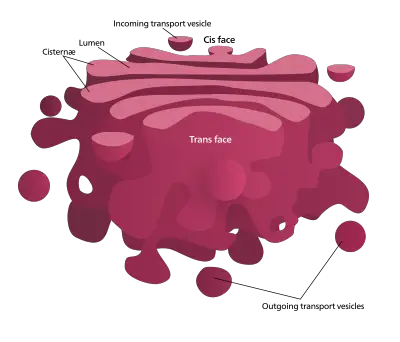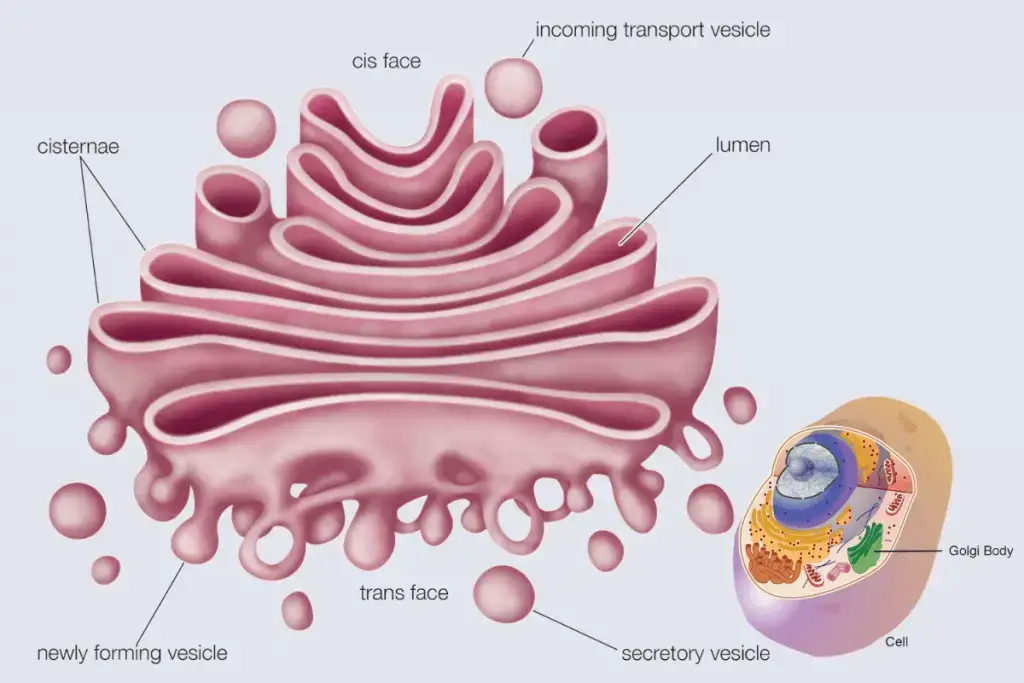What is Golgi Body (Golgi Complex)?
- The Golgi body, also known as the Golgi complex, Golgi apparatus, lipochondrion, Barker’s body, and Dalton complex, is a membrane-bound organelle predominantly found in eukaryotic cells. This complex structure was first observed in 1898 by Camillo Golgi, an Italian cytologist, in the nerve cells of owls and cats. Originally termed the internal reticular apparatus, it was later named after Golgi. The Golgi body’s structure is characterized by smooth membrane saccules or cisternae, tubules, vesicles, and golgian vacuoles.
- Functionally, the Golgi body plays a critical role in the processing and packaging of proteins and lipids. Proteins exiting the endoplasmic reticulum enter the Golgi apparatus, where they are encapsulated in vesicles. These vesicles then transport the proteins and lipids to various cellular destinations, such as the plasma membrane, lysosomes, or they may be secreted out of the cell. This function underscores the Golgi body’s vital role in the cellular secretory pathway.
- The Golgi complex may consist of distinct subunits, namely Golgiosomes, idiosomes, or dictyosomes. In plants and lower invertebrates, it is often referred to as a dictyosome. The form, size, and number of the Golgi body vary based on its location within the cell. Its polymorphic nature allows it to change shape, adapting to the specific needs of the cell. In certain algae, there may be only one Golgi body, while in plant cells, the number can be as high as 25,000.
- Distribution-wise, the Golgi body is absent in prokaryotic cells but is a staple feature in eukaryotic cells. However, there are exceptions within the eukaryotic domain, such as male gametes of bryophytes and pteridophytes, mature sieve tubes, and red blood cells of animals, where the Golgi body is notably absent.
- The Golgi body’s significance in cellular function is further highlighted by its historical nomenclature. Before being universally recognized as the Golgi apparatus, it was referred to as the Golgi-Holmgren ducts and the Golgi-Kopsch apparatus. These historical references underscore the organelle’s central role in cell biology and its evolutionary significance in the animal and plant kingdoms.
Definition of Golgi Body (Golgi Complex)
The Golgi body, also known as the Golgi complex or Golgi apparatus, is a membrane-bound organelle found in most eukaryotic cells. It functions primarily in the processing, packaging, and distribution of proteins and lipids, which are transported in vesicles to various destinations within the cell, including the plasma membrane and lysosomes, or secreted outside the cell. The Golgi complex is characterized by its unique structure of flattened, stacked pouches called cisternae.
Location of Golgi Body (Golgi Complex)
The location of the Golgi body (Golgi Complex) in eukaryotic cells can be comprehensively understood by organizing the information into specific sections:
- Presence in Eukaryotic Cells
- The Golgi apparatus is a ubiquitous feature in eukaryotic cells, with notable exceptions. It is absent in male gametes of bryophytes and pteridophytes, mature sieve tubes, some fungal cells, mature sperms, and red blood cells (RBCs) of animals.
- Notably, the Golgi complex is not found in prokaryotic cells, highlighting its role in more complex cellular processes exclusive to eukaryotes.
- Configuration in Animal Cells
- In animal cells, the Golgi complex can either exist as a single entity or as a connected complex.
- This leads to two conditions: localized, as observed in most vertebrate cells, and diffused, common in most invertebrate cells, liver cells, and nerve cells of vertebrates.
- The localized Golgi apparatus is typically compact and situated between the nucleus and the cell periphery.
- Conversely, the diffused Golgi complex forms a network, often found encircling the nucleus in nerve cells.
- Structure in Plant Cells
- In contrast to animal cells, the Golgi apparatus in plant cells consists of numerous unconnected units known as dictyosomes.
- The number of dictyosomes varies significantly, ranging from a single unit in certain algae to as many as 25,000 in the rhizoidal cell of Chara.
- On average, a typical plant cell contains about 10-20 dictyosomes.
- In the context of liver cells, up to 50 units of the Golgi apparatus, termed Golgisomes, can be present.
Structure of Golgi body

The Golgi body is a dynamic structure, with its shape and size varying according to the physiological state of the cell. It is typically composed of four main parts: cisternae, tubules, vesicles, and vacuoles.
- Cisternae
- The Golgi body generally consists of 4 to 8 cisternae, although this number can increase to as many as 60 in some single-celled organisms.
- Cisternae are the functional units of the Golgi complex, characterized by a smooth membrane of variable thickness that encloses a fluid-filled lumen or matrix.
- The margins of each cisterna are often curved, imparting a particular polarity to the Golgi body, with one face (convex) being the forming or cis-face directed towards the nucleus, and the other face (concave) being the maturing or trans-face directed towards the plasma membrane.
- The forming face receives vesicles from the smooth endoplasmic reticulum, while the maturing face is involved in budding off secretion, coated or Golgian vesicles, or vacuoles.
- Tubules
- These are short, branched structures that interconnect the various cisternae.
- Tubules, typically around 30-50 nm in diameter, form a complex network around the periphery and maturing face of the Golgi apparatus.
- Their primary function is in the elaboration of secretory products.
- Vesicles
- Vesicles are small sacs, with diameters ranging from 20-80 nm, that develop from tubules.
- They are classified into two types: coated vesicles, which have a rough surface due to fine bristle-like outgrowths and are involved in endocytosis, and smooth vesicles, which contain secretory substances and assist in exocytosis.
- Golgian Vacuoles
- These are enlarged parts of the cisternae that form round vesicles or sacs.
- Golgian vacuoles often contain amorphous or granular substances and can function as lysosomes.

Golgi body Functions/Golgi complex function
- Secretory Functions
- The primary function of the Golgi complex is the secretion of various substances like gum, mucus, sweat, tears, and saliva.
- It receives proteins, pro-enzymes, lipids, steroids, and other substances from the Endoplasmic Reticulum (ER), either directly or via transitional vesicles.
- The Golgi complex concentrates, modifies, and packages these biochemicals into secretion vesicles, which are then released from the cell through processes like exocytosis or reverse pinocytosis.
- Membrane Transformation and Recycling
- The Golgi complex plays a critical role in transforming one type of membrane into another.
- It converts the membrane of the ER into selectively permeable plasma membranes, differentiated membranes of lysosomes, etc.
- Additionally, it participates in the recycling of the cell membrane, which is essential for maintaining cellular homeostasis.
- Formation of Cell Structures
- In plant cells, the Golgi complex is instrumental in forming the cell plate during cell division, achieved by the fusion of vesicles produced by the Golgi complex.
- It also contributes to the formation of complex polysaccharides for the plant cell wall.
- Enzymatic Processing and Modification
- The Golgi bodies are sites for post-translational modifications and enzymatic processing such as glycosylation and phosphorylation, which occur near the membrane surface.
- Some vesicles or vacuoles of the Golgi complex store digestive enzymes obtained from the ER in an inactive state, functioning later as primary lysosomes.
- Formation of Sperm Acrosomes and Root Hairs
- The vesicles of the Golgi complex are involved in forming acrosomes of sperms, which are crucial for the fertilization process.
- Additionally, the Golgi complex aids in the formation of root hairs from their mother cells.
- Plasma Membrane Formation after Cytokinesis
- The membrane of the Golgi complex’s vesicles contributes to the formation of the plasma membrane after cytokinesis, ensuring the proper separation and functioning of newly formed cells.
References
- Alberts, B. (2004). Essential cell biology. New York, NY: Garland Science Pub.
- Verma, P. S., & Agrawal, V. K. (2006). Cell Biology, Genetics, Molecular Biology, Evolution & Ecology (First edition). S . Chand and Company Ltd
- Shakya M, Mehata KR, Gautam MK, Pokhrel KR and Khanal K (2020 ) “ Principles of Biology”, Asmita Books Publisher and Distributors Ltd, Bhotahity, Nepal
- https://www.biologydiscussion.com/cell/golgi-apparatus/golgi-apparatus-meaning-structure-and-functions
- https://www.biologydiscussion.com/eukaryotic-cell/golgi-apparatus-of-eukaryote-cells-with-diagram/5956
- https://www.biologydiscussion.com/cell/golgi-complex/golgi-complex-structure-and-functions-with-diagram/36799
- Text Highlighting: Select any text in the post content to highlight it
- Text Annotation: Select text and add comments with annotations
- Comment Management: Edit or delete your own comments
- Highlight Management: Remove your own highlights
How to use: Simply select any text in the post content above, and you'll see annotation options. Login here or create an account to get started.